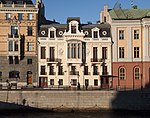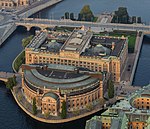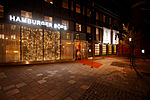Arvfurstens palats

Arvfurstens palats (Palace of the Hereditary Prince) is a palace located at Gustav Adolfs Torg in central Stockholm. Designed by Erik Palmstedt, the palace was originally the private residence of Princess Sophia Albertina. It was built 1783-1794 and declared a historical monument (byggnadsminne) in 1935 and subsequently restored by Ivar Tengbom in 1948-52. Since 1906 the palace has served as the seat of the Ministry for Foreign Affairs. The palace is facing the square Gustav Adolfs torg, with the Royal Swedish Opera on the opposite side. Located near the palace are the Sager Palace, official residence of the prime minister, and Rosenbad, official office of the government. The bridge Norrbro stretches past the Riksdag on Helgeandsholmen and further south to Stockholm Old Town and the Royal Palace.
Excerpt from the Wikipedia article Arvfurstens palats (License: CC BY-SA 3.0, Authors, Images).Arvfurstens palats
Gustav Adolfs Torg, Stockholm Norrmalm (Norrmalms stadsdelsområde)
Geographical coordinates (GPS) Address External links Nearby Places Show on map
Geographical coordinates (GPS)
| Latitude | Longitude |
|---|---|
| N 59.329166666667 ° | E 18.067777777778 ° |
Address
Arvfurstens palats
Gustav Adolfs Torg
103 21 Stockholm, Norrmalm (Norrmalms stadsdelsområde)
Sweden
Open on Google Maps










